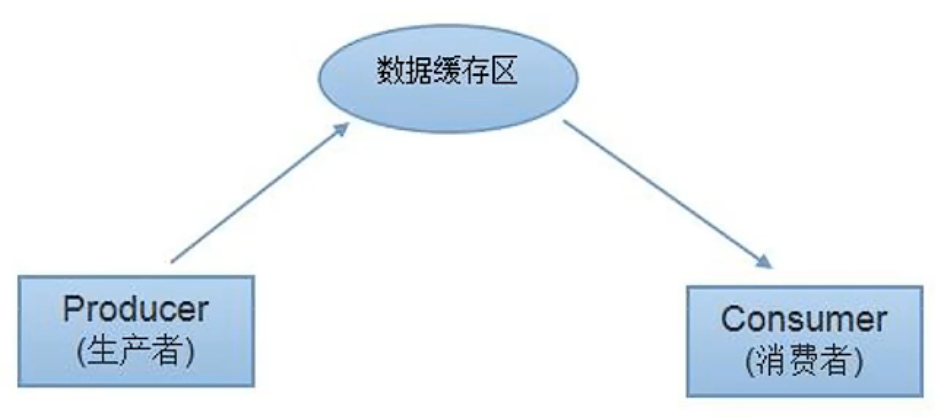高级主题
高级主题
线程协作
- 生产者消费者模式:生产者和消费者共享同一个资源,并且生产者和消费者之间相互依赖,互为条件
- 对生产者,没产品之前通知消费者等待;生产产品后,马上通知消费者
- 对消费者,消费之后通知生产者消费结束,开始新的生产
- synchronized不足以完成消费者生产者问题,只实现了同步,不能实现通信
- 线程通信:java提供的几个通信方法
| 方法名 | 作用 |
|---|---|
| wait() | 表示线程一直等待,直到其他线程通知,会释放锁(对比sleep) |
| wait(long timeout) | 指定等待的毫秒数 |
| notify() | 唤醒一个处于等待状态的线程 |
| notifuAll() | 唤醒同一个对象上所有调用wait()方法的线程,优先级高的先调度 |
解决方式1
并发协作模型“生产者/消费者模式”----管程法
- 生产者:负责生产数据的模块(可能是方法、对象、线程、进程)
- 消费者:负责处理数据的模块(可能是方法、对象、线程、进程)
- 缓冲区:生产者投入缓冲区,消费者从缓冲区取出

//管程法:利用缓冲区
public class TestPC {
public static void main(String[] args) {
SynContainer container = new SynContainer();
new Productor(container).start();
new Consumer(container).start();
}
}
//生产者
class Productor extends Thread{
SynContainer container;
public Productor(SynContainer container){
this.container = container;
}
//生产方法
@Override
public void run() {
for (int i = 1; i < 20; i++) {
System.out.println("生产了"+i+"只鸡");
try {
container.push(new Chicken(i));
} catch (InterruptedException e) {
e.printStackTrace();
}
}
}
}
class Consumer extends Thread{
SynContainer container;
public Consumer(SynContainer container){
this.container = container;
}
@Override
public void run() {
for (int i = 1; i < 20; i++) {
try {
System.out.println("消费了第"+container.pop().id+"只鸡");
} catch (InterruptedException e) {
e.printStackTrace();
}
}
}
}
class Chicken{
int id;
public Chicken(int id) {
this.id = id;
}
}
class SynContainer{
//需要一个容器大小
Chicken[] chickens = new Chicken[10];
//容器计数
int count = 0;
//生产者放入产品
public synchronized void push(Chicken chicken) throws InterruptedException {
//如果容器满了,等消费者消费
if(count==chickens.length){
//通知消费者,生产等待
this.wait();
}
//没满,继续加入容器
chickens[count] = chicken;
count++;
//通知消费者
this.notify();
}
//消费者拿出产品
public synchronized Chicken pop() throws InterruptedException {
if (count==0){
//等生产者生产,消费者等待
this.wait();
}
//如果可以消费
count--;
Chicken chicken = chickens[count];
//吃完了,返回吃完的鸡,通知生产者再生产
this.notify();
return chicken;
}
}
解决方式2
并发协作模型“生产者/消费者模式”----信号灯法
//信号灯法:设置标志位
public class TestPC2 {
public static void main(String[] args) {
TV tv = new TV();
new Player(tv).start();
new Watcher(tv).start();
}
}
//演员--生产者
class Player extends Thread{
TV tv;
public Player(TV tv) {
this.tv = tv;
}
@Override
public void run() {
for (int i = 0; i < 20; i++) {
if(i%2==0){
tv.play("起飞");
}else {
tv.play("美甲的窃魂卷");
}
}
}
}
//观众--消费者
class Watcher extends Thread{
TV tv;
public Watcher(TV tv) {
this.tv = tv;
}
@Override
public void run() {
for (int i = 0; i < 20; i++) {
tv.watch();
}
}
}
//节目--产品
class TV{
String voice;
boolean flag = true;
//表演
public synchronized void play(String voice){
if (!flag){
try {
this.wait();
} catch (InterruptedException e) {
e.printStackTrace();
}
}
System.out.println("演员表演了"+voice);
//通知观众
this.notifyAll();
this.voice=voice;
this.flag=!this.flag;
}
//观看
public synchronized void watch(){
if (flag){
try {
this.wait();
} catch (InterruptedException e) {
e.printStackTrace();
}
}
System.out.println("观看了"+voice);
this.notifyAll();
this.flag=!this.flag;
}
}
线程池
- 背景:处理并发情况下的线程,经常创建、销毁,影响性能
- 思路:提前创建好多个线程,放入线程池,使用时直接获取,使用完放回池中(公共交通)
- 好处:
- 响应速度plus,资源消耗down
- 便于管理:
- corePoolSize:核心池大小
- maximumPoolSize:最大线程数
- keepAliveTime:线程没有任务时最多保存的时间
- API:ExecutorService和Executors
- ExecutorService:真正的线程池接口。常见子类ThreadPoolExecutor
| 方法 | 作用 |
|---|---|
| void executor(Runnable command) | 执行任务,没有返回值,一般用来执行Runnable |
| 执行任务,有返回值,一般用来执行Callable | |
| void shutdown() | 关闭连接池 |
-
- Excutors:工具类、线程池的工厂类,用于创建并返回不同类型的线程池
public class TestPool { public static void main(String[] args) { //1.创建线程池 //newFixedThreadPool参数为:线程池大小 ExecutorService service = Executors.newFixedThreadPool(10); //执行 service.execute(new MyThread()); service.execute(new MyThread()); service.execute(new MyThread()); service.execute(new MyThread()); //2.关闭连接 service.shutdown(); } } class MyThread implements Runnable{ @Override public void run() { System.out.println(Thread.currentThread().getName()); } } /*输出 pool-1-thread-1 pool-1-thread-2 pool-1-thread-4 pool-1-thread-3 */






 浙公网安备 33010602011771号
浙公网安备 33010602011771号